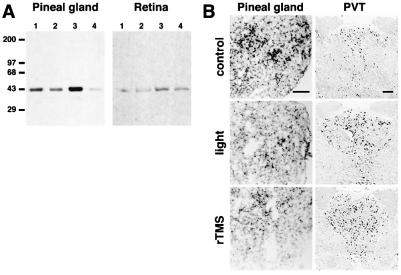Figure 5.
Comparative analysis of the effects of rTMS and light exposure on pinealocytes and retina. (A) Effects of rTMS on pineal gland and retina during the light phase of the circadian rhythm. Western blot analysis of pineal gland and retinal extracts with antisera specific for the phosphorylated form of CREB (pCREB) is shown. Background levels of pCREB in pineal and retina are shown in lanes 1. rTMS at 10% power does not increase pCREB immunoreactivity (lanes 2), whereas rTMS at 100% power is able to induce strong CREB phosphorylation within 15 min (lanes 3). At 45 min pCREB immunoreactivity is reduced in both tissues (lanes 4). Experiments were performed three times. (B) rTMS and light stimulation in the dark phase of the circadian rhythm produce similar changes in c-fos expression in pinealocytes and PVT neurons. Stimulations were performed at 2:00 a.m. (rTMS as described in Materials and Methods; light stimulation 10 min, 40 W). (Top) c-fos mRNA expression in control regions. (Middle and Bottom) c-fos expression in the pineal gland and in the PVT after rTMS and light stimulation, respectively. Both stimulation modalities produce a strong reduction of c-fos expression in pinealocytes and a robust induction of c-fos expression in PVT neurons.

